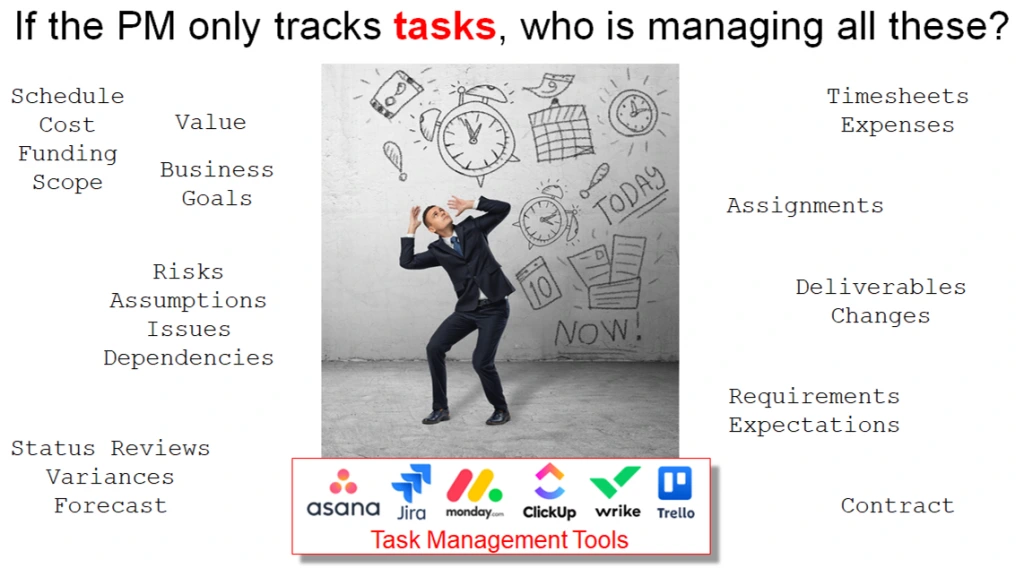The Project Management Office must focus on outcomes, or it will be considered a cost center. Companies often realize they need to implement a PMO when the number of ongoing projects is huge, and managers need to control they finish on time, within budget, meeting business objectives, and delivering value, but they don’t have the physical time to govern projects effectively.
Projects are becoming increasingly complex. The PMO doesn’t have the resources to effectively manage all projects, which can be more than 500 in execution.

The PMO should govern projects; it shouldn’t manage them directly. It should delegate the management to project professionals responsible for ensuring the success of each project, capable of being accountable, anticipating problems, and proposing and implementing corrective actions before it’s too late.

A project professional is not just someone doing reporting, task assignation and task tracking. They should devote time to professionally managing the project, which includes, among other activities:
- Controlling schedule, budget, funding, and scope.
- Helping the team get value-driven delivery and meet the project business goals.
- Managing Risk, Assumptions, Issues and Dependencies (RAID).
- Communicating frequent project status reviews, assessing the project work, pointing out areas for improvement, and actions to be taken.
- Measuring variances and calculating forecasts.
- Monitoring timesheets and expenses of team members.
- Assigning tasks to team members (on predictive projects).
- Managing deliverables and changes.
- Managing requirements and stakeholder expectations.
- Ensuring contract terms and conditions.
To address the technical challenge of governing 50-500 complex concurrent projects, with many stakeholders, many organizations adopt antipatterns. These are counterproductive strategies that, once implemented, fail to achieve the goal of improving organizational project management maturity. Implementation failures convince executives that PMOs are cost centers that don’t add value, discourage people engagement, and close doors to project professionals.
«Antipatterns emerge when the PMO is not designed by a Project Manager.»
Many organizations end up suffering the negative consequences of a PMO created based on one or several PMO implementation antipatterns.
1) The IT Specialist

IT specialist antipattern for implementing PMOs involves assigning the task of managing 50-500 concurrent projects to an IT specialist:
- Projects will be modeled as an aggregation of tasks. The technical solution will be based on task tracking tools. The result will be a project management information system to digitize tasks, documents, and forms under tools like Jira, Azure DevOps, Notion, Coda, Monday, ClickUp, Smartsheet or Asana. Even worse, they could invent custom tools to control tasks, with the ongoing high maintenance cost.
- After a refinement phase based on technical input from project teams, the new project management system will become mandatory and other tools will be banned. In practice, project management efforts are devoted to fix problems in projects as they arise, reactively. The practical way of managing projects are meetings, face to face or remote, quite fatiguing for people involved, who also lack contextual visibility. “They cannot see the wood for the trees.” Projects are not prioritized or structured into business units, portfolios, or programs.
- What happens when team members don’t enter data into these tools? Who is to be asked for the project finish date? Who is held accountable when the project fails, finish late, or over budget? If tools calculate one thing and project managers say otherwise, who has the right version of the truth?
2) The Consultant

Consulting antipattern for implementing PMOs involves assigning the task of designing the PMO to a project management consultant:
- Significant effort will be done to analyze the current situation, future scenarios, gap identification, strategic action plan, etc. Managers will understand that, in order to manage projects, procedures must first be changed. Those activities tagged as “operations” will be descoped. Project typology will be elaborated according to the project life cycle phases. Visible results will be document templates and training plans on project, programs, and portfolio management.
- To control the growing number of complex projects, implementing implementing PPM tools is necessary. This includes high licensing costs or integration with corporate information systems, as well as maintaining a permanent team of consultants who often spend most of their time managing the tool and preparing reports.
- What happens when management decides it’s not the right time to undertake these strategic changes? Who will waste their time writing documents that nobody reads?
3) The Process Expert

Business Process Redesign antipattern for implementing PMOs involves asking a process expert to industrialize projects as operations, as if they were assembly lines in a factory:
- Different types of projects will be modeled as processes, defining workflows and approval processes, automated steps, metrics and KPIs, identifying bottlenecks, improvement goals, etc. It will take several months of definition and training before any project starts to be managed under the new processes.
- Projects are not repetitive or stable. Projects are to transform ideas into reality. They depend heavily on the human factor. They are natural systems, not artificial ones; they follow the law of the farm. They are not operational industrial work but rather knowledge work. People involved in projects should not feel like cogs in a machine. It’s highly effective to provide them with visibility, context, and, above all, to give them a voice.
- What happens when people discover that they can bypass some process steps to achieve better, faster, and more valuable results for the business?
4) The Data Scientist

Data Science antipattern for implementing PMOs means a data scientist tries to solve the problem of managing 50-500 projects by automating some numerical reports:
- He or she will identify data sources, design data extraction, transformation, and loading processes, data marts, graphical visualizations of historical series, status, trends, indicators, KPIs, etc. The result will be a project management information system based on Excel and PowerPoint reports, more or less automated. Some PMOs use PowerBI or Tableau.
- Managers will see a series of dashboards that convey a deceptive sense of control. At best, if the fact tables accurately represent the state of the projects, there will only be retrospective measurement of what has already happened and is beyond remedy.
- Will responses arrive in time to improve the performance of projects in red? What happens when the traffic light indicators are green, but everybody knows the projects are not doing well?
After these failed experiences, organizations don’t usually blame the non-project professionals who implemented the PMO. They tend to blame themselves, saying, “we are different, we don’t run projects like an engineering company.” They assume that project management is bureaucracy that involves task data entering, document reading, attending meetings, following workflows, and generating dashboards. Any subsequent initiative to implement a PMO has to overcome new barriers of resistance to change.
Implementing PMOs with PMPeople
PMPeople is the tool for the Project Economy. All types of organizations manage projects, programs, and portfolios to turn ideas into reality. Organizations are getting “projectified” and need project professionals to ensure predictability, accountability, and final success of each project.
At PMPeople, we use the term “XPMO” to refer to a PMO without processes, which can be implemented effectivelly thanks to the collaboration among people using different roles.
The concept of XPMO is based on the agile framework XP (eXtreme Programming). In 1996, Ken Beck invented a software development framework based on suggestions from his programming teams, which proposed an extreme software development approach, drastically avoiding any activities that generated waste while preserving those focusing on value. Thus, they created a framework based on 12 engineering practices and 5 roles.

Similarly, the eXtreme PMO (XPMO) is based on roles and practices. It eliminates bureaucracy because people collaborate on what adds value, using simple habits to record artifacts in the initiation, planning, execution, and closing phases at the right time, giving a voice to those who need to supervise, manage, and stay informed.
«eXtreme PMO (XPMO) avoids bureaucracy through roles and value-driven practices.»
Individuals interact in the management of the projects they are involved in, using collaborative roles:

The eXtreme PMO (XPMO) is based on collaborative roles and practices aimed to manage projects without processes:

- Structure: Organize projects in business units, portfolios, and programs.
- Packages: Manage projects by managing work packages.
- IPECA: Standardize the project lifecycle (Initiation, Planning, Execution, Closing, Archive).
- Reviews: Publish small and frequent project status reviews.
PMPeople is a technology for project professionals to collaborate using roles. Launched in April 2018 for PMOs and project professionals using 12 collaborative roles to work in teams professionally, in the cloud, collaborating on projects, programs and portfolios.
PMPeople goes beyond simply following workflows, chains of supervision, processes, or document templates: it promotes people interact as individuals. Project Managers can manage projects at many organizations using predictive and agile frameworks. Stakeholders can supervise many projects and give feedback with their mobile application. Team members can know their teammates and job descriptions, submit comments, timesheets, expenses, etc.
PMPeople stands for “People collaborating on Project Management”. It is aimed to unify professional project management by these differential points:
- Designed by and for professional project managers, following professional project management standards.
- Online productivity –less meetings, less documents, less workflows– through distributed collaboration among 12 specialized roles: Organization Owner, 6 roles on demand management and 5 roles on supply management.
- Freemium product –unlimited time, unlimited users– usable via web and mobile application.
Start using PMPeople for free, for unlimited time and for any number of users. In premium organizations, only managers have a cost. Several roles –stakeholders, team members, sponsors, and resource managers– are always free. You can increase or decrease your premium seats according to the organization’s actual needs. Premium organizations have access to our online interactive support. Our servers are located in the EU. This software can also be hosted on customer premises.
Jose Barato
Related posts
Categories
- Business (16)
- Demand Management Roles (14)
- Frequently Asked Questions (7)
- Guide (26)
- People (23)
- Assignments (2)
- Feedback (2)
- Project Team (3)
- Tracking Time And Expenses (2)
- Process (9)
- Closing (2)
- Executing And Controlling (2)
- Planning (1)
- Project Management (67)
- Management Frameworks (18)
- Organization Owner (OO) (3)
- Project Economy (54)
- Tools (19)
- Supply Management Roles (5)
- Training (6)
- Uncategorized (1)





